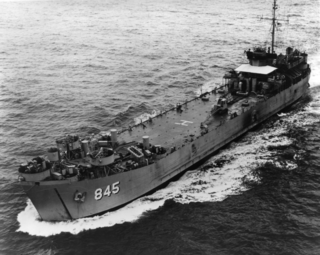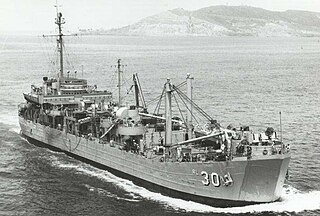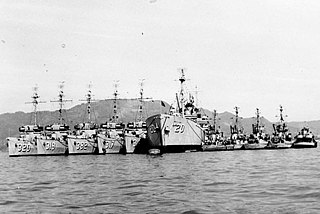
USS Thompson (DD-627) was first a Gleaves-class destroyer, then became an Ellyson-class destroyer minesweeper. She was the second Navy ship named "Thompson", and the first named in honor of Robert M. Thompson.

USS Manchester was a Cleveland-class light cruiser of the United States Navy, which were built during World War II. The class was designed as a development of the earlier Brooklyn-class cruisers, the size of which had been limited by the First London Naval Treaty. The start of the war led to the dissolution of the treaty system, but the dramatic need for new vessels precluded a new design, so the Clevelands used the same hull as their predecessors, but were significantly heavier. The Clevelands carried a main battery of twelve 6-inch (152 mm) guns in four three-gun turrets, along with a secondary armament of twelve 5 in (127 mm) dual-purpose guns. They had a top speed of 32.5 knots.

The third USS Los Angeles (CA-135) was a Baltimore-class heavy cruiser, laid down by the Philadelphia Navy Yard, Philadelphia, on 28 July 1943 and launched on 20 August 1944. She was sponsored by Mrs. Fletcher Bowron and commissioned on 22 July 1945, with Captain John A. Snackenberg in command.

The third USS Rochester (CA-124), an Oregon City-class heavy cruiser, was laid down 29 May 1944 by Bethlehem Steel Co., Quincy, Massachusetts; launched 28 August 1945; sponsored by Mrs. M. Herbert Eisenhart, wife of the president of Bausch & Lomb Optical Co., Rochester, New York; and commissioned 20 December 1946 at the Boston Navy Yard.

USS Stembel (DD-644) was a Fletcher-class destroyer in service with the United States Navy from 1942 to 1947 and from 1951 to 1958. In 1961, she was transferred to Argentina where she served as ARA Rosales (D-22). She was scrapped in 1982.

USS Conway (DD/DDE-507), a Fletcher-class destroyer, was the second ship of the United States Navy to be named for William Conway, who distinguished himself during the Civil War.

USS Zeal (AM-131) was an Auk-class minesweeper that served in both World War II and during the Korean War. As a steel-hulled fleet minesweeper, she was assigned to support the fleet by removing enemy mines whose purpose was to impede the path of the U.S. Pacific Fleet.

USS Endicott (DD-495), was a Gleaves-class destroyer of the United States Navy.

USS Rowan (DD-782) was a Gearing-class destroyer of the United States Navy, the fourth Navy ship named for Vice Admiral Stephen C. Rowan (1805–1890).

USS Pledge (AM-277) was an Admirable-class minesweeper built for the U.S. Navy during World War II. She was built to clear minefields in offshore waters, and served the Navy in the Atlantic Ocean and then was transferred to the North Pacific Ocean. She survived the world war and was awarded one battle star, but, during the Korean War, she struck a mine and was sunk. She received the Presidential Unit Citation for her Korean service.

USS Jefferson County (LST-845) was an LST-542-class tank landing ship built for the United States Navy during World War II. Named after counties in 25 states, she was the only U.S. Naval vessel to bear the name.

USS Askari (ARL-30) was one of 39 Achelous-class landing craft repair ships built for the United States Navy during World War II. Askari is an Arabic word for soldier, a term frequently applied to indigenous troops in Africa serving European colonial powers, particularly the British and Germans in East Africa from the late 19th century to the end of World War I; ARL-30 has been the only U.S. naval vessel to bear the name.
USS Swift (AM-122) was an Auk-class minesweeper acquired by the United States Navy for the dangerous task of removing mines from minefields laid in the water to prevent ships from passing.
USS Symbol (AM-123) was an Auk-class minesweeper acquired by the United States Navy for the dangerous task of removing mines from minefields laid in the water to prevent ships from passing.

USS Impeccable (AM-320) was an Auk-class minesweeper built for the United States Navy during World War II. She was originally ordered as HMS Brutus (BAM-7) for the United Kingdom's Royal Navy under Lend-Lease, but was acquired and renamed by the United States Navy before construction began. She was commissioned in 1944 and served in the Pacific before being decommissioned in 1947. After the outbreak of hostilities in Korea, Impeccable was recommissioned in 1952 and served off Korea through 1952. She was decommissioned for the final time in October 1955 and placed in reserve. She was sold for scrapping in 1974.

USS Gladiator (AM-319) was an Auk-class minesweeper acquired by the U.S. Navy for the dangerous task of removing mines from minefields laid in the water to prevent ships from passing.

USS Chief (AM-315) was an Auk-class minesweeper acquired by the United States Navy for the dangerous task of removing mines from minefields laid in the water to prevent ships from passing, and named after the word "chief," the head or leader of a group.

USS Lipan (AT-85) was a Navajo-class fleet tug constructed for the United States Navy during World War II. Her purpose was to aid ships, usually by towing, on the high seas or in combat or post-combat areas, plus "other duties as assigned." She served in the Pacific Ocean during World War II and the Korean War. She was awarded two battle stars for World War II and four battle stars for the Korean War.

USS Silverstein (DE-534) was a John C. Butler-class destroyer escort in service with the United States Navy from 1944 to 1947 and from 1951 to 1958. She was sold for scrapping in 1973.

USS Apache (AT-67/ATF-67) was a Navajo-class fleet tug, later fleet ocean tug, in commission in the United States Navy from 1942 to 1946 and from 1951 to 1974. She saw service in World War II, the Korean War, and the Vietnam War.

















